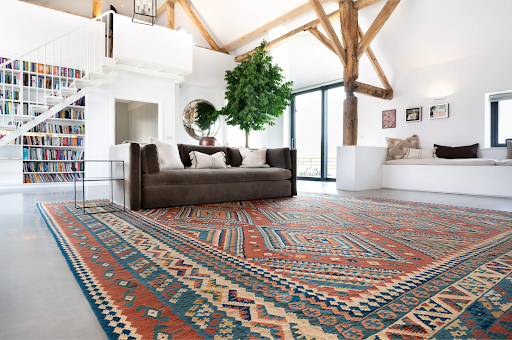Oriental rugs have origins in Turkey, China, Tibet, India, Pakistan, and Egypt. Persian rugs come from what was the ancient Middle Eastern empire of Persia, which would be modern-day Iran and some parts of Pakistan and Afghanistan.
People often interchange Persian and Oriental rugs as there isn’t much of a difference between them. Considering Persian rugs are a form of Oriental rugs, the difference only lies in the country of origin.
When you think about it, the oldest rug designs, such as the flatweave, were already around thousands of years ago throughout Asia, the Mediterranean, and the Caucasus mountain region. Countries in these regions, like Turkey, Iran, Morocco, Egypt, and India, have a rich history of rug-making.
That said, both Oriental and Persian rugs tend to have an elegant and exotic look unique to them.
If you’re going for a Persian or Oriental rug and wondering how to marry them into your space, read our tips for decorating with these rugs.
1. Is it the Centerpiece?
As we mentioned, Oriental and Persian rugs tend to be super elegant. They hardly shy away from bold colors like red and blue and come in rich, intricate patterns.
If you want the rug to be the focal point of the room, you likely want it to capture attention and be the piece that holds every other part of your decor together.
In this case, you don’t want to go for muted colors, as bold Persian and Oriental rugs are a perfect fit. Keep the size small and place the rug at the center of the room for a blended look.
2. Decide Your Look
Oriental and Persian rugs are as versatile as they come. They are rich in patterns and colors that complement any style you want or stand out.
What is your interior design style?
If you’re into dark colors, bright and muted rugs may be a perfect fit. Just avoid primary colors and go with less vibrant shades.
In a bright and airy room, an elegant rug with bold details will bring the best out of your space.
3. Work with Your Palette
Whether you have a particular decor style or not, you can choose to focus on the colors in your space. It’s simple and practical and doesn’t require any experience decorating.
Take note of the dominant colors in your space and buy a Persian or Oriental rug that will blend well with one or two of those colors. You could bring in more accessories in the same color as the rug to help it blend.
Throw pillows, metal finishes, plants, and artwork are great items to assist the rug in blending in.
4. Decking Your Hallway
While hallways are generally bare, it’s not uncommon to have a rug in the hallway.
A short hallway doesn’t really need decorating with a rug, but if it’s particularly long, you could minimize the emptiness with a hallway runner that complements your decor.
Your hallway runner may or may not look like your area rug.
5. Multiple Rugs
Multiple rugs in one room may sound like a bad idea, but it’s an interesting way to decorate with rugs, especially if the space is large.
When dealing with extra large spaces like a large living room or an open floor plan interior, multiple rugs are a lot better than a single large rug that doesn’t break space for distinct areas of the room.
You probably have a dining space or workspace in the same area as the living room. Place an area rug in each of the spaces but don’t worry about colors or patterns.
While multiple rugs in varying shades of the same color will be a unifying factor, distinct colors and patterns are just as good. The difference makes the rugs more complementary, which is easier to pull off than matching them.
6. Go Monochromatic
We’ve discussed choosing one or more dominant colors in your rug and working your decor around it.
But with a monochromatic color scheme, you just need to work with one color but play with various shades. If the furniture has a darker shade, get a Persian or Oriental rug of a lighter shade, and vice versa.
If you’re sure about taking risks, a monochromatic design would be a safer bet for your rug.
Conclusion
It would be perfect if you could start on a blank slate when working with Persian and Oriental rugs. That way, you can pair everything from scratch. However, these types of rugs have no shortage of color, pattern, and texture, which makes it easier to fit them into any design.








